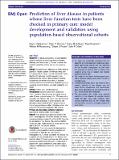Prediction of liver disease in patients whose liver function tests have been checked in primary care : model development and validation using population-based observational cohorts
Abstract
OBJECTIVE: To derive and validate a clinical prediction model to estimate the risk of liver disease diagnosis following liver function tests (LFTs) and to convert the model to a simplified scoring tool for use in primary care. DESIGN: Population-based observational cohort study of patients in Tayside Scotland identified as having their LFTs performed in primary care and followed for 2 years. Biochemistry data were linked to secondary care, prescriptions and mortality data to ascertain baseline characteristics of the derivation cohort. A separate validation cohort was obtained from 19 general practices across the rest of Scotland to externally validate the final model. SETTING: Primary care, Tayside, Scotland. PARTICIPANTS: Derivation cohort: LFT results from 310 511 patients. After exclusions (including: patients under 16 years, patients having initial LFTs measured in secondary care, bilirubin >35 μmol/L, liver complications within 6 weeks and history of a liver condition), the derivation cohort contained 95 977 patients with no clinically apparent liver condition. Validation cohort: after exclusions, this cohort contained 11 653 patients. PRIMARY AND SECONDARY OUTCOME MEASURES: Diagnosis of a liver condition within 2 years. RESULTS: From the derivation cohort (n=95 977), 481 (0.5%) were diagnosed with a liver disease. The model showed good discrimination (C-statistic=0.78). Given the low prevalence of liver disease, the negative predictive values were high. Positive predictive values were low but rose to 20-30% for high-risk patients. CONCLUSIONS: This study successfully developed and validated a clinical prediction model and subsequent scoring tool, the Algorithm for Liver Function Investigations (ALFI), which can predict liver disease risk in patients with no clinically obvious liver disease who had their initial LFTs taken in primary care. ALFI can help general practitioners focus referral on a small subset of patients with higher predicted risk while continuing to address modifiable liver disease risk factors in those at lower risk.
Citation
McLernon , D J , Donnan , P T , Sullivan , F M , Roderick , P , Rosenberg , W M , Ryder , S D & Dillon , J F 2014 , ' Prediction of liver disease in patients whose liver function tests have been checked in primary care : model development and validation using population-based observational cohorts ' , BMJ Open , vol. 4 , no. 6 , e004837 . https://doi.org/10.1136/bmjopen-2014-004837
Publication
BMJ Open
Status
Peer reviewed
ISSN
2044-6055Type
Journal article
Rights
© 2014 the Author(s). This is an Open Access article distributed in accordance with the terms of the Creative Commons Attribution (CC BY 3.0) license, which permits others to distribute, remix, adapt and build upon this work, for commercial use, provided the original work is properly cited. See: http://creativecommons.org/licenses/by/3.0/
Description
This work was supported by the UK National Health Service Research & Development Programme Health Technology Assessment Programme (project number 03/38/02) and also by the Backett Weir Russell Career Development Fellowship, University of Aberdeen.Collections
Items in the St Andrews Research Repository are protected by copyright, with all rights reserved, unless otherwise indicated.

